Kentucky Pest News Newsletter
HIGHLIGHTS IN THIS ISSUE
Number 1063__________July 5, 2005
WATCH FOR
TOBACCO
SOYBEAN
FRUIT
SHADE TREES AND ORNAMENTALS
LIVESTOCK
HOUSEHOLD
DIAGNOSTIC LAB HIGHLIGHTS
IPM TRAP COUNTS
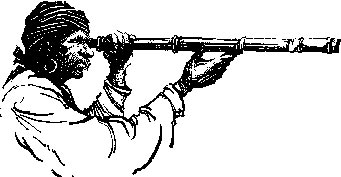
WATCH FOR
WATCH FOR:
By Lee Townsend
- Emergence of WESTERN CORN ROOTWORMS (Entfact 141)
- SILK CLIPPING by JAPANESE BEETLES and CORN ROOTWORM BEETLES (ID 45)
- WOOLLY ALDER APHIDS on silver maple
- BURROWING SOD WEBWORMS in lawns
- BURROWER BUGS in crops and turf
- MASKED CHAFER BEETLES are flying at night, they are one source of white grub problems in turf.

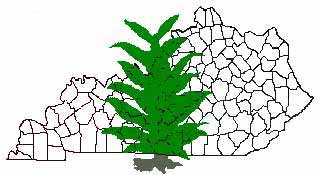
TOBACCO
BLUE MOLD FOUND IN HARDIN COUNTY
By Kenny Seebold
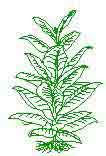 Blue mold made its first appearance in the United States this year near Cecilia, Kentucky. The sudden appearance of the disease in our Commonwealth has left us "experts" scratching our heads over blue mold showing up during a dry spell, plus I've had to change the paragraph that I've been using for this column the past 2 months.
Blue mold made its first appearance in the United States this year near Cecilia, Kentucky. The sudden appearance of the disease in our Commonwealth has left us "experts" scratching our heads over blue mold showing up during a dry spell, plus I've had to change the paragraph that I've been using for this column the past 2 months.
Here's what we know about the blue mold situation in Kentucky as of July 5. We have had only one confirmed case of blue mold - the case in Hardin Co. (Eastview, near Cecilia) that was confirmed this past week. Samples were sent to our diagnostic lab on June 27 from the field in question. Gary Palmer and I visited the field on June 29 and confirmed the presence of blue mold, and Julie Beale (our diagnostician) made a positive ID on the samples that were sent on June 27. Blue mold was fairly widespread in the field we looked at, and it appeared that 2 sporulation cycles had occurred. We forwarded this information to our colleagues at the North American Plant Disease Forecast Center and they are in the process of analyzing weather data from the past month to get a better idea of when the initial infections occurred and where the inoculum originated.
Hardin Co. remains under a blue mold warning (disease confirmed - take preventive action immediately),
while the counties surrounding Hardin are under a blue mold watch (disease not confirmed - spores may
be present; be prepared to take preventive action. We also want to urge growers to destroy any
unused plants that may still be in float beds, as these could become an "invisible" reservoir of
disease should they become infected. The North American Plant Disease Forecast Center generated a
spore trajectory map from the Cecilia outbreak on July 1 (
http://www.ces.ncsu.edu/depts/pp/bluemold/forecasts/b050701cecilia.php). A weak cold front moved through the Commonwealth from the north this past week, creating a moderate risk for tobacco production areas in southeastern Kentucky and a slightly lower risk for northeast Tennessee (based upon predicted spore movement from the Cecilia source).
Based on this information, growers in southeastern Kentucky should be on the lookout for blue mold and
be prepared to initiate fungicide applications if the disease is found or if weather conditions
become favorable for disease development. For the current week, conditions remain
less-than-favorable for a widespread epidemic of blue mold. Keep in mind that these forecasts have
a margin of error and give us only a general picture of the potential for development of blue mold
in an area. As we have learned, blue mold can show up when and where it is least expected!
Growers should scout fields thoroughly for symptoms of disease and other problems.
Please contact us if blue mold is found in your area, and remember to send a sample to our diagnostic
lab in Lexington or Princeton for confirmation of the first cases found in a given county. Some
growers may be hesitant to report blue mold for fear of negative publicity; however, timely
reporting of disease outbreaks helps us get the word out to the tobacco community so that everyone
can take necessary actions to protect their crops. There is no need for a grower to be embarrassed
about getting blue mold - anyone can get it!
SECTION 18 GRANTED FOR QUADRIS ON TOBACCO
By Kenny Seebold
 Quadris has been granted an exemption from its existing label under Section 18 of FIFRA. The exemption covers two diseases of tobacco - frogeye leaf spot and target spot - and is valid from June 25, 2005 until October 15, 2005. A full (Section 3) label is expected by the end of 2005 that will include frogeye leaf spot, target spot, and blue mold.
Quadris has been granted an exemption from its existing label under Section 18 of FIFRA. The exemption covers two diseases of tobacco - frogeye leaf spot and target spot - and is valid from June 25, 2005 until October 15, 2005. A full (Section 3) label is expected by the end of 2005 that will include frogeye leaf spot, target spot, and blue mold.
The recommended rate of application is 8 oz/A, for a maximum of 32 oz/A during the season (4 applications max.). Using Quadris at less-than-recommended rates is legal, but performance may be impacted and the manufacturer will not be liable for control failures if reduced rates were used. Some growers have been told that they can use 6 oz/A and achieve good disease control. This is risky! Applying the proper 8 oz/A rate costs about $3.75/A more than the 6 oz/A application, but the extra cost could well be worth it considering the explosive nature of tobacco diseases and the high value of the crop. Each grower must have a copy of the Section 18 in his or her possession at the time of application.
Quadris should be applied only when conditions favor development of frogeye leaf spot or target spot. Frogeye is favored by warm, humid weather; target spot is more likely to occur during periods of moderate temperatures and high humidity or moisture (similar to conditions that favor blue mold). We encourage growers and agents to scout crops and report any frogeye or target spot to us as quickly as possible so that we can alert the tobacco community and begin timely application of Quadris.
Quadris is not a systemic fungicide and does not have any curative activity. The material should be applied preventively for maximum suppression of disease. This means putting out the material at the earliest signs of disease at the latest. Applying Quadris to heavily infected crops can lead to development of resistance in pathogen populations and a loss of this important tool for disease management.
Quadris can be applied up to the day of harvest, but only one application of the fungicide is permitted in the 30 days prior to harvest.
For the latest blue mold status and other tobacco disease information, check the KY Blue Mold Warning System online.
 http://www.uky.edu/Agriculture/kpn/kyblue/kyblue.htm
http://www.uky.edu/Agriculture/kpn/kyblue/kyblue.htm

For more information about tobacco pests, visit
"Insect Management Recommendations".

SOYBEAN
FUNGICIDE USE IN SOYBEAN FOR "PLANT HEALTH" AND SOYBEAN RUST "CONTROL"
By Don Hershman
 Many Kentucky soybean producers are considering spraying soybean during the early reproductive stages (R3-R4) with a strobilurin fungicide in an attempt to tap into the real, but very unpredictable, "plant health" benefit that is occasionally seen when soybean is sprayed with a strobilurin (e.g., Headline or Quadris). It is debatable whether or not this is a best management practice for soybean because of the randomness of the apparent economic benefit associated with the treatment. Nevertheless, many producers will soon be spraying soybean with a strobilurin fungicide. Many of these same producers are thinking about adding a triazole to the mix for rust protection. In my opinion, adding a triazole at this time is likely to be a waste of money. Fact is, strobilurins provide protection against soybean rust should it blow in and the chances are extremely remote at this time that the curative activity of a triazole is needed.
Many Kentucky soybean producers are considering spraying soybean during the early reproductive stages (R3-R4) with a strobilurin fungicide in an attempt to tap into the real, but very unpredictable, "plant health" benefit that is occasionally seen when soybean is sprayed with a strobilurin (e.g., Headline or Quadris). It is debatable whether or not this is a best management practice for soybean because of the randomness of the apparent economic benefit associated with the treatment. Nevertheless, many producers will soon be spraying soybean with a strobilurin fungicide. Many of these same producers are thinking about adding a triazole to the mix for rust protection. In my opinion, adding a triazole at this time is likely to be a waste of money. Fact is, strobilurins provide protection against soybean rust should it blow in and the chances are extremely remote at this time that the curative activity of a triazole is needed.
Regardless of which fungicide is used, the "clock" starts ticking at the moment of application, and at best fungicides will provide 21-28 days protection against soybean rust. This means that any fungicide deployed in early July will be mostly (if not entirely) GONE by the end of the July. The way things are shaping up, that is just about the time when you may REALLY need to spray for soybean rust. My point is that if you are considering spraying a fungicide now for plant health benefit, do not expect the treatment to have a significant impact on any future soybean rust control needs. You may still need to spray again for soybean rust. It is in everyone's best interest that soybean rust control be a "no-spray or one-spray system". Those who hold off on spraying at this time are very likely to achieve this goal. Those spraying now for plant health and rust "insurance" are setting themselves up to possibly have to make two sprays.
Of those considering spraying a fungicide in the near future, many are thinking about spraying Headline SBR, which is a co-pack of Headline and Folicur. From a plant health stand point, growers should be aware that the recommended use rate for Headline SBR results in less Headline being applied than has been associated with plant health gains. The significant point is that it is unproven and unknown if and how the lower rate of Headline will impact plant health. Note, triazoles have no potential for providing a plant health benefit unless a disease is being controlled.
If you choose to spray Headline SBR, I will caution you about the use of adjuvants with the application. The Headline SBR label does not say anything about the use of adjuvants. Information provided to me by BASF (Technical Information Bulletin) says that "a non-ionic surfactant may be used", but also to "check for compatability, efficacy and crop safety". Basically, you are on your own. I am saying this, because I have recently seen two reports where significant levels of phytotoxicity have been seen (by researchers in Oklahoma and Tennessee), when an adjuvant was added to Headline SBR. The impact of this phytotoxicity on yield (if any) is unknown. Note, phytotoxicity has not been seen when straight Headline is mixed with an adjuvant, or when an adjuvant is mixed with Quadris. In the Oklahoma study, phytoxicity was seen with many, but not all, triazoles. This is early work, so I cannot go into detail at this time. I choose to specifically mention Headline SBR since observations were made by two scientists in two states, and because the stage is set to see a lot of Headline SBR being sprayed in Kentucky this summer.
BURROWER BUGS - THEY CAN BE ANYWHERE
By Lee Townsend
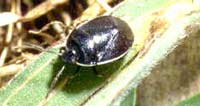 Large numbers of white-margined burrower bugs can be seen crawling over crop fields and lawns, or on plant foliage. This one- eighth to one-fourth inch long black insect has an oval body with a distinct thin white line running along each side. The shiny appearance and rounded back gives it a beetle-like look but it is a true bug with piercing-sucking mouthparts. The nymph, or immature stage, has a similar shape but is red and black.
Large numbers of white-margined burrower bugs can be seen crawling over crop fields and lawns, or on plant foliage. This one- eighth to one-fourth inch long black insect has an oval body with a distinct thin white line running along each side. The shiny appearance and rounded back gives it a beetle-like look but it is a true bug with piercing-sucking mouthparts. The nymph, or immature stage, has a similar shape but is red and black.
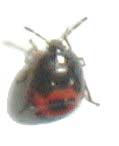
While the white-margined burrower bug may be abundant in crops fields or turf, there is little indication that it damages crops. It feeds on seeds and may remove sap from plant roots. Females deposit groups of 50 to 150 eggs in small chambers in the soil and stay with them until they hatch. The females then bring small seeds from mint, henbit, purple deadnettle, or horsenettle as food for the tiny nymphs. After feeding on the provisioned seed, the nymphs move off to fend for themselves.
These insects can become a nuisance around homes if the wandering adults and nymphs become accidental invaders. A barrier spray with a pyrethroid (e.g. Spectracide® Bug Stop® Multi-Purpose Insect Control Concentrate, Bayer Advanced Garden Multi-Insect Killer Concentrate, etc.) may stop the movement. Direct sprays with insecticidal soap are an alternative but leave no residual protection.
For more information about soybean pests, visit
"Insect Management Recommendations".

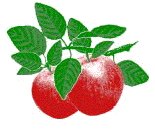
FRUIT
AVOIDING RASPBERRY DISEASES
By John Hartman
 Raspberries are a rewarding crop for the backyard garden because it is possible to obtain a harvest of high quality fruit with appropriate management. Good control of diseases can almost always be obtained with proper site selection and timely cultural practices, thus minimizing the need for pesticides. Red and black raspberries are threatened by cane diseases such as anthracnose, spur blight, and cane blight. Both are susceptible to gray mold fruit rot and also to Septoria leaf spot. Black raspberry is susceptible to orange rust, but red raspberries are not. Both types of raspberry are susceptible to Phytophthora root rot and Verticillium wilt.
Raspberries are a rewarding crop for the backyard garden because it is possible to obtain a harvest of high quality fruit with appropriate management. Good control of diseases can almost always be obtained with proper site selection and timely cultural practices, thus minimizing the need for pesticides. Red and black raspberries are threatened by cane diseases such as anthracnose, spur blight, and cane blight. Both are susceptible to gray mold fruit rot and also to Septoria leaf spot. Black raspberry is susceptible to orange rust, but red raspberries are not. Both types of raspberry are susceptible to Phytophthora root rot and Verticillium wilt.
The following is a checklist of cultural practices that will minimize raspberry disease problems:
- Start with healthy plants from a reputable nursery; virus-free stocks are preferred.
- Choose a well-drained planting site with good air movement and sunlight exposure. If there are doubts about the soil drainage, build a raised bed to minimize Phytophthora root rot disease. Red raspberry cultivars such as Boyne, Killarney, Latham, Newburgh, Nordic, and Prelude are tolerant to resistant to root rot. Fall-bearing cultivars such as Anne, Caroline, and Josephine and black raspberries such as Bristol, Dundee, and Jewel are also resistant.
- To minimize the threat from Verticillium wilt, avoid sites where tomatoes, potato, eggplants, or strawberries have been grown within the last three years. No raspberry cultivars are resistant to Verticillium wilt.
- Selecting fall-fruiting varieties such as Heritage minimizes cane blights and cankers because cane diseases are eliminated when canes are cut and removed in late winter. Leaf spot disease fungi which are harbored on the canes are also removed in this way.
- For summer-bearing raspberries, prune out the old canes just after the last fruit have been harvested in early July, leaving the new canes for next year's fruit production. Otherwise the old canes can be source of infection of the new canes.
- Maintain a row width between 1-2 feet to maximize ventilation and rapid drying. Stake or trellis the rows or plants so that the canes are held upright for better air movement.
- If irrigation is needed, avoid sprinkler irrigation which can spread diseases. Mulch the raspberries to conserve water and minimize disease-favoring foliage wetting.
- Harvest berries promptly to avoid letting berries become overripe. Remove berries with gray mold or other fruit rot diseases from the planting.
- Dig up diseased plants, including roots, and burn or discard them.
- If black raspberries are being grown, destroy nearby stands of wild brambles to minimize the threat of orange rust disease.
LIVESTOCK

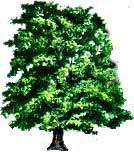
SHADE TREES AND ORNAMENTALS
WOOLLY ALDER APHIDS ON SILVER MAPLE
By Lee Townsend
 Woolly alder aphids are among the more conspicuous shade tree pests because they produce large fuzzy white masses on the underside of silver maple leaves. While these sap feeders can cause heavily infested leaves to pucker and drop prematurely, they probably don't have an adverse effect on long term tree health. The aphids can be a considerable nuisance because they excrete large volumes of a sticky liquid waste called "honeydew". A rain of honeydew can leave the ground sticky, attracted many bees, wasps, and flies to a free, sweet meal, and support the growth of sooty mold on infested trees. Control is rarely justified.
Woolly alder aphids are among the more conspicuous shade tree pests because they produce large fuzzy white masses on the underside of silver maple leaves. While these sap feeders can cause heavily infested leaves to pucker and drop prematurely, they probably don't have an adverse effect on long term tree health. The aphids can be a considerable nuisance because they excrete large volumes of a sticky liquid waste called "honeydew". A rain of honeydew can leave the ground sticky, attracted many bees, wasps, and flies to a free, sweet meal, and support the growth of sooty mold on infested trees. Control is rarely justified.
For the next few weeks, the blue-black winged form of the woolly alder aphid will disperse through the air as a floating mass of white waxy filaments. This curious sight can be alarming but is of no consequence. Lucky floating aphids will land on alders, the other host needed for their life cycle.
BLACK VINE WEEVILS ARE TROUBLE
By Lee Townsend
Crescent-shaped notches in leaves of landscape plants at this time of year can mean that the black vine weevil is around. Adults of this one-half inch long oblong dark snout beetle emerge from pupation cells in the soil and crawl up on to plants to feed. They must feed for 3 weeks or more before they are ready to lay eggs in the soil or under surface litter around host plants. Light to moderate feeding damage apparently has little impact on plant health. While the weevil prefers Taxus, hemlock, or rhododendron, it can feed on over 100 trees, shrubs, vines, and flowers. The white, legless larvae feed on fine roots but can move to, and girdle, larger roots at the base of the plant, especially if there are many of them, or if the soil is moist.
If an infestation is suspected, you can check plants for the nocturnal adults at night with a flashlight or leave some folded heavy cloth on the ground around the base of the plants. Weevils may be found hiding in this material during the day.
Adult control is based on killing all of the weevils before they begin to lay eggs. A residual insecticide containing bifenthrin, cyfluthrin, or permethrin, should provide reasonably good adult control but two applications, about 3 weeks apart are needed. There are grub control alternatives, that may be useful in some instances.


HOUSEHOLD
MOSQUITO OPTIONS FOR HOMEOWNERS
By Mike Potter
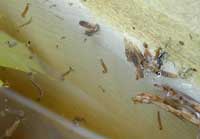 Despite the lack of rainfall, mosquito season is in full swing in Kentucky. Although the risks of contracting West Nile Virus are slight, mosquitoes are a perennial nuisance for which there is no easy solution. As summer continues, there will be an abundance of misinformation about what works and what does not. The following measures can afford some relief.
Despite the lack of rainfall, mosquito season is in full swing in Kentucky. Although the risks of contracting West Nile Virus are slight, mosquitoes are a perennial nuisance for which there is no easy solution. As summer continues, there will be an abundance of misinformation about what works and what does not. The following measures can afford some relief.
Eliminate Breeding Sites - Mosquitoes need quiet, non-flowing water for their development. Eliminating sources of standing water, such as swamps and ditches, may require community-wide effort. Nonetheless, homeowners can take steps to prevent mosquitoes from breeding on their property:
1. Dispose of old tires, buckets, aluminum cans, plastic sheeting or other refuse that can hold water. Empty accumulated water from trashcans, boats, wheelbarrows, pet dishes, and flowerpot bottoms, and if possible turn them over when not in use.
2. Clean debris from rain gutters and unclog obstructed down spouts. Clogged or damaged rain gutters are one of the most overlooked mosquito breeding sites around homes.
3. Change water in birdbaths and wading pools at least weekly, and keep swimming pools clean, chlorinated or covered when not in use. Ornamental pools can be aerated or stocked with mosquito-eating fish. Aeration and water movement helps because mosquitoes prefer quiet, non-flowing water for egg laying and development.
4. Fill or drain ditches, swampy areas, and other soil depressions and remove, drain or fill tree holes and stumps with mortar to prevent water accumulation. Eliminate standing water and seepage around animal watering troughs, cisterns, and septic tanks. Be sure cistern screens are intact and access covers fit tightly.
Larval Control - Use of a mosquito larvicide can be beneficial when it is impractical to eliminate a breeding site. Larvicides are insecticides used to control immature mosquitoes before they have a chance to develop into biting adults. Most larvicides sold to homeowners contain either the ingredient methoprene, or the bacterium Bacillus thuringiensis israelensis (Bti).
Neither active ingredient is harmful to fish, waterfowl, pets or humans when used according to label directions. Many products and formulations containing methoprene (Altosid®) and Bti (Bactimos®, Vectobac®) are used by mosquito abatement agencies and other professionals. Homeowners can purchase the methoprene-based larvicide, PreStrike™ in hardware stores. PreStrike is formulated as a granule and comes in a shaker bottle. Various products containing the mosquito- specific bacterium, Bti, are also sold to homeowners. Mosquito Dunks® and Quick Kill® Mosquito Granules, for example, can be found at hardware and discount stores.
Adult Control - Adult mosquitoes prefer to rest in moist, shady areas such as dense vegetation during the daytime. Consequently, homeowners should remove tall weeds and overgrown vegetation from their yards. To further reduce intolerable levels of biting adult mosquitoes, residual insecticides can be applied to shrubs, hedges and other shaded areas, such as under decks and along foundations. Recent research by University of Kentucky entomologists indicates that such treatments effectively suppress nuisance, biting mosquitoes for about a month. Residual mosquito sprays are often best applied by professional pest control firms. Homeowners opting to try this themselves should use lawn and garden insecticides containing permethrin (e.g., Ortho Mosquito B Gone, Spectracide Mosquito Stop), cyfluthrin (Bayer Advanced Powerforce Mosquito Killer), bifenthrin (e.g., Ortho Home Defense Max), or lambda cyhalothrin (Spectracide Triazicide). For homeowners, a hose-end sprayer is usually most effective for making such applications.
Exclusion - Mosquitoes can be kept out of homes by securely screening windows, doors and porches. The occasional mosquito found indoors can be eliminated with a fly swatter. Aerosol-type insecticides labeled for mosquitoes, gnats, and other flying insects seldom provide much relief at the dosages applied by householders.
Topically-Applied Repellents - Repellents will help prevent bites when spending time outdoors. Traditionally, the most effective mosquito repellents contained the active ingredient diethyl toluamide (DEET) ranging from 5% to 40%. Higher percentages of DEET in the ingredients provide longer protection. Low -percentage formulations (10% or less) are suitable for shorter periods outdoors (e.g., 1 to 2 hrs), and are recommended for use with young children. Earlier this year, two new mosquito repellents were registered by the U.S. Environmental Protection Agency and recommended as alternatives to DEET by the Centers for Disease Control and Prevention. Picaridin (7% Cutter Advanced) and Lemon eucalyptus oil (30% Repel Lemon Eucalyptus) provide relief for about 2 to 4 hrs. Unlike DEET-based repellents, Picaridin is essentially odorless and Lemon eucalyptus oil has a lemon scent. For many people, the new products will also have a more pleasing feel on the skin. Both repellents should be appearing on store shelves soon. Always read and follow directions on the container.
Other Control Possibilities - Many consumer products claim to attract, repel, capture or kill mosquitoes. Most of these devices do not appreciably reduce mosquito abundance or incidence of bites, or else their claims are unproven. Electrocuting devices or "bug zappers" using ultraviolet light as an attractant are generally ineffective in reducing outdoor populations of mosquitoes and their biting activity. Studies indicate that mosquitoes make up only a tiny percentage of the insects captured in such traps. The majority are moths, beetles and other harmless night flying insects. Other types of mosquito traps utilize carbon dioxide, warmth, light, and various chemicals (e.g. octenol) as attractants and claim to capture tremendous numbers of adult mosquitoes. Such devices can be quite expensive. Performance claims to the contrary, such traps seldom have been shown to reduce populations of biting mosquitoes on one's property, or the frequency of bites. In some situations, they could even attract more mosquitoes into the area they were meant to protect.
Advertisements for portable electronic devices using high frequency, ultrasonic sound routinely appear in magazines, claiming to keep mosquitoes and other pests at bay. Some supposedly repel mosquitoes by mimicking the wing beat frequency of a hungry dragonfly. Scientific studies have repeatedly shown these devices to be of negligible benefit in deterring mosquitoes and reducing bites. Save your money, as these devices seldom if ever provide any appreciable measure of protection.
Citronella oil does have mosquito-repelling properties and the scented candles can provide some protection. For maximum effect, use multiple candles placed close (within a few feet) of where people are sitting. A single candle located at the center or edge of a picnic blanket probably will not provide much benefit other than atmosphere. Mosquito-repellent plants, garlic, and other oft-advertised botanical products generally are ineffective.
Bats and certain types of birds (e.g. purple martins) are often cited as effective natural agents for managing outdoor mosquitoes. Conservation groups and nature magazines often suggest building bat and birdhouses on one's property to promote nesting and to protect against mosquitoes. Although insectivorous bats and birds do eat mosquitoes, they make up only a very small portion of their natural diet. Much like the mechanical "bug zappers," bats and birds capture all manner of other flying insects also. Efforts to colonize and conserve these animals should not be done with the primary intent of diminishing biting mosquitoes.
When it comes to managing mosquitoes, a good rule of thumb is if the approach or device sounds too good to be true - it probably is.

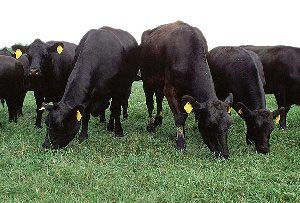
LIVESTOCK
WHAT CAN YOU DO ABOUT HORSE FLIES?
By Lee Townsend
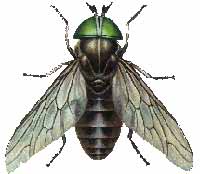 Horse flies and deer flies are bloodsucking insects that can be serious pests of horses, cattle, and humans. Horse flies range in size from 3/4 to 1-1/4 inches long and usually have clear or solidly colored wings and brightly colored eyes. Deer flies, which commonly bite humans, are smaller with dark bands across the wings and colored eyes similar to those of horse flies. Attack by a few of these persistent flies can make outdoor work and recreation miserable. The numbers of flies and the intensity of their attack vary from year to year.
Horse flies and deer flies are bloodsucking insects that can be serious pests of horses, cattle, and humans. Horse flies range in size from 3/4 to 1-1/4 inches long and usually have clear or solidly colored wings and brightly colored eyes. Deer flies, which commonly bite humans, are smaller with dark bands across the wings and colored eyes similar to those of horse flies. Attack by a few of these persistent flies can make outdoor work and recreation miserable. The numbers of flies and the intensity of their attack vary from year to year.
Female horse flies and deer flies are active during the day. These flies apparently are attracted to such things as movement, shiny surfaces, carbon dioxide, and warmth. Once on a host, they use their knife-like mouthparts to slice the skin and feed on the blood pool that is created. Bites can be very painful and there may be an allergic reaction to the salivary secretions released by the insects as they feed. The irritation and swelling from bites usually disappears in a day or so. However, secondary infections may occur when bites are scratched.
Horse flies and deer flies are active for specific periods of time during the summer. Repellents such as Deet and Off (N-diethyl-meta-toluamide) can protect humans for several hours. Follow label instructions because some people can develop allergies with repeated use, look for age restrictions.
Permethrin-based sprays are labeled for application to livestock and horses. These insecticides are very irritating to the flies and cause them to leave almost immediately after landing. Often, the flies are not in contact with the insecticide long enough to be killed so they continue to be an annoyance. These flies will swarm persistently around animals and feed where the spray coverage was not complete (underbelly or legs) or where it has worn off. Repeated applications may be needed. Check the label about minimum retreatment intervals. Pyrethrin sprays also are effective but do not last as long as permethrin.
Horse fly and deer fly larvae develop in wet or moist areas, such as wetlands, or along creek and river banks, where they are predators. Consequently, it is impossible to locate and eliminate breeding sites. Also, the adults are strong fliers that may be coming from some distance away. That leaves personal and animal protection as the viable choices.
For more information livestock pests, visit
"Insect Management Recommendations".

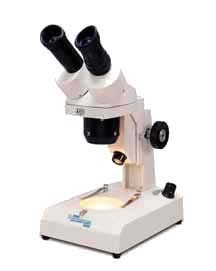
DIAGNOSTIC LAB HIGHLIGHTS
DIAGNOSTIC LAB - HIGHLIGHTS
By Julie Beale and Paul Bachi
During the past week, we have seen symptoms of potassium deficiency-due in large part to the dry soil conditions in many areas of the state--on numerous field crop and vegetable samples including corn, alfalfa, tobacco, soybean, and pepper. We have also diagnosed on field crops: phosphorus deficiency, gray leaf spot and northern leaf blight on corn; thrips injury, manganese toxicity and Phytophthora stem blight on soybean; blue mold (first case this year in Ky.); bacterial blackleg, Pythium root rot, black shank, stem canker/soreshin (Rhizoctonia), tomato spotted wilt virus, alfalfa mosaic virus, tobacco ringspot virus and Fusarium wilt on tobacco.
On fruit and vegetable samples, we have diagnosed anthracnose and Botrytis blight on raspberry; fire blight and cedar-apple rust on apple; fire blight on pear; black rot on grape; Leucostoma canker on peach; brown rot on plum; bean yellow mosaic virus on bean; bacterial soft rot on potato; stinkbug injury on sweet corn; Septoria leaf spot, early blight, Pythium root rot and tomato spotted wilt virus on tomato.
On ornamentals and turf, we have diagnosed bacterial soft rot on hosta; Pythium root rot on calibrachoa and petunia; powdery mildew and Discula anthracnose on dogwood; Cercosporella leaf spot on mulberry; Gloeosporium leaf spot on birch; anthracnose on sycamore; Phomopsis twig blight on juniper; Sphaeropsis tip blight on spruce; white pine decline, pine bark adelgid and pine tip moth on pine; localized dry spot and anthracnose on bentgrass; and many cases of brown patch on fescue.

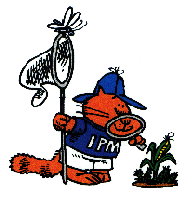
IPM TRAP COUNTS:
By Patty Lucas, University of Kentucky Research Center
UKREC-Princeton, KY, June 24-July 1, 2005
| True Armyworm
| 4
|
| Corn Earworm
| 1
|
| European Corn Borer
| 0
|
| Southwestern Corn Borer
| 1
|
|
UKREC, Princeton KY
True Armyworm
Corn earworm 1
European corn borer 0
Southwestern corn borer 1
View Princeton trap counts for the entire 2005 season at -
http://www.uky.edu/Ag/IPMPrinceton/Counts/2005trapsfp.htm
Fulton County trap counts are available at -http://ces.ca.uky.edu/fulton/anr/Insect%20Counts.htm
For information on trap counts in southern Illinois visit the Hines Report at -
http://www.ipm.uiuc.edu/pubs/hines_report/comments.html
The Hines Report is posted weekly by Ron Hines, Senior Research Specialist, at the
University of Illinois Dixon Springs Agricultural Center.
NOTE: Trade names are used to simplify the information presented in
this newsletter. No endorsement by the Cooperative Extension Service
is intended, nor is criticism implied of similar products that are not
named.
Lee Townsend
Extension Entomologist
BACK
TO KY PEST NEWS HOME
 Blue mold made its first appearance in the United States this year near Cecilia, Kentucky. The sudden appearance of the disease in our Commonwealth has left us "experts" scratching our heads over blue mold showing up during a dry spell, plus I've had to change the paragraph that I've been using for this column the past 2 months.
Blue mold made its first appearance in the United States this year near Cecilia, Kentucky. The sudden appearance of the disease in our Commonwealth has left us "experts" scratching our heads over blue mold showing up during a dry spell, plus I've had to change the paragraph that I've been using for this column the past 2 months.




 Large numbers of white-margined burrower bugs can be seen crawling over crop fields and lawns, or on plant foliage. This one- eighth to one-fourth inch long black insect has an oval body with a distinct thin white line running along each side. The shiny appearance and rounded back gives it a beetle-like look but it is a true bug with piercing-sucking mouthparts. The nymph, or immature stage, has a similar shape but is red and black.
Large numbers of white-margined burrower bugs can be seen crawling over crop fields and lawns, or on plant foliage. This one- eighth to one-fourth inch long black insect has an oval body with a distinct thin white line running along each side. The shiny appearance and rounded back gives it a beetle-like look but it is a true bug with piercing-sucking mouthparts. The nymph, or immature stage, has a similar shape but is red and black.


 Raspberries are a rewarding crop for the backyard garden because it is possible to obtain a harvest of high quality fruit with appropriate management. Good control of diseases can almost always be obtained with proper site selection and timely cultural practices, thus minimizing the need for pesticides. Red and black raspberries are threatened by cane diseases such as anthracnose, spur blight, and cane blight. Both are susceptible to gray mold fruit rot and also to Septoria leaf spot. Black raspberry is susceptible to orange rust, but red raspberries are not. Both types of raspberry are susceptible to Phytophthora root rot and Verticillium wilt.
Raspberries are a rewarding crop for the backyard garden because it is possible to obtain a harvest of high quality fruit with appropriate management. Good control of diseases can almost always be obtained with proper site selection and timely cultural practices, thus minimizing the need for pesticides. Red and black raspberries are threatened by cane diseases such as anthracnose, spur blight, and cane blight. Both are susceptible to gray mold fruit rot and also to Septoria leaf spot. Black raspberry is susceptible to orange rust, but red raspberries are not. Both types of raspberry are susceptible to Phytophthora root rot and Verticillium wilt.

 Woolly alder aphids are among the more conspicuous shade tree pests because they produce large fuzzy white masses on the underside of silver maple leaves. While these sap feeders can cause heavily infested leaves to pucker and drop prematurely, they probably don't have an adverse effect on long term tree health. The aphids can be a considerable nuisance because they excrete large volumes of a sticky liquid waste called "honeydew". A rain of honeydew can leave the ground sticky, attracted many bees, wasps, and flies to a free, sweet meal, and support the growth of sooty mold on infested trees. Control is rarely justified.
Woolly alder aphids are among the more conspicuous shade tree pests because they produce large fuzzy white masses on the underside of silver maple leaves. While these sap feeders can cause heavily infested leaves to pucker and drop prematurely, they probably don't have an adverse effect on long term tree health. The aphids can be a considerable nuisance because they excrete large volumes of a sticky liquid waste called "honeydew". A rain of honeydew can leave the ground sticky, attracted many bees, wasps, and flies to a free, sweet meal, and support the growth of sooty mold on infested trees. Control is rarely justified.

 Despite the lack of rainfall, mosquito season is in full swing in Kentucky. Although the risks of contracting West Nile Virus are slight, mosquitoes are a perennial nuisance for which there is no easy solution. As summer continues, there will be an abundance of misinformation about what works and what does not. The following measures can afford some relief.
Despite the lack of rainfall, mosquito season is in full swing in Kentucky. Although the risks of contracting West Nile Virus are slight, mosquitoes are a perennial nuisance for which there is no easy solution. As summer continues, there will be an abundance of misinformation about what works and what does not. The following measures can afford some relief.

 Horse flies and deer flies are bloodsucking insects that can be serious pests of horses, cattle, and humans. Horse flies range in size from 3/4 to 1-1/4 inches long and usually have clear or solidly colored wings and brightly colored eyes. Deer flies, which commonly bite humans, are smaller with dark bands across the wings and colored eyes similar to those of horse flies. Attack by a few of these persistent flies can make outdoor work and recreation miserable. The numbers of flies and the intensity of their attack vary from year to year.
Horse flies and deer flies are bloodsucking insects that can be serious pests of horses, cattle, and humans. Horse flies range in size from 3/4 to 1-1/4 inches long and usually have clear or solidly colored wings and brightly colored eyes. Deer flies, which commonly bite humans, are smaller with dark bands across the wings and colored eyes similar to those of horse flies. Attack by a few of these persistent flies can make outdoor work and recreation miserable. The numbers of flies and the intensity of their attack vary from year to year.

